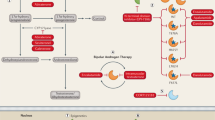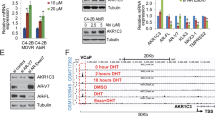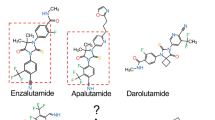Abstract
Androgen receptor (AR) signaling has a key role in the pathogenesis of prostate cancer. AR gene amplification, AR overexpression, and activating mutations in the AR occur more frequently as castration-resistant prostate cancer (CRPC) evolves, with intratumoral androgen levels remaining sufficient for AR activation despite castration. The source of these androgens might be either adrenal or intratumoral. AR signaling, therefore, remains a valid treatment target for patients with CRPC. CYP17 is a key enzyme for androgen biosynthesis. The imidazole antifungal agent ketoconazole weakly and nonspecifically inhibits CYP17, but remains unlicensed for this indication. Chemists at the Cancer Research UK Centre for Cancer Therapeutics have designed a novel, selective, irreversible inhibitor of CYP17 called abiraterone, which is more than 20 times more potent than ketoconazole. Abiraterone acetate, a prodrug, has undergone phase I assessment, and is rapidly progressing from phase II to phase III trials, in view of its high level of antitumor activity. This agent is safe and well tolerated, and activity profiles suggest that approximately 50% of CRPC remains AR-ligand driven. Other CYP17 inhibitors with alternative mechanisms of action, for example VN/124-1, are in preclinical development. The rationale for and implications of CYP17 inhibition and the CYP17-targeting agents in development are discussed in this Review.
Key Points
Androgens and androgen receptor signaling have a key role in the pathogenesis of castration-resistant prostate cancer
CYP17 inhibitors might affect both adrenal and de novo castration-resistant androgen synthesis
CYP17 inhibitors that are more than 20-fold more potent and are more specific than ketoconazole have now been developed
Tumor responses seen in patients treated with the CYP17 inhibitors ketoconazole and abiraterone acetate confirm that a significant proportion of castration-resistant prostate cancers remain hormone driven
Abiraterone acetate, an agent that specifically and irreversibly inhibits CYP17, is well tolerated and preliminary data suggests that it has considerable antitumor activity in patients with prostate cancer
This is a preview of subscription content, access via your institution
Access options
Subscribe to this journal
Receive 12 print issues and online access
$209.00 per year
only $17.42 per issue
Buy this article
- Purchase on Springer Link
- Instant access to full article PDF
Prices may be subject to local taxes which are calculated during checkout


Similar content being viewed by others
References
Huggins C and Hodges CV (1941) Studies on prostate cancer: the effect of castration, estrogen and androgen injection on serum phosphatases in metastatic carcinoma of the prostate. Cancer Res 1: 293–297
Hellerstedt BA and Pienta KJ (2002) The current state of hormonal therapy for prostate cancer. CA Cancer J Clin 52: 154–179
Taplin ME (2007) Drug Insight: role of the androgen receptor in the development and progression of prostate cancer. Nat Clin Pract Oncol 4: 236–244
Small EJ and Ryan CJ (2006) The case for secondary hormonal therapies in the chemotherapy age. J Urol 176 (Suppl 1): S66–S71
Attard G et al. (2006) Improving the outcome of patients with castration-resistant prostate cancer through rational drug development. Br J Cancer 95: 767–774
Tomlins SA et al. (2005) Recurrent fusion of TMPRSS2 and ETS transcription factor genes in prostate cancer. Science 310: 644–648
Tomlins SA et al. (2006) TMPRSS2:ETV4 gene fusions define a third molecular subtype of prostate cancer. Cancer Res 66: 3396–3400
Tomlins SA et al. (2007) Distinct classes of chromosomal rearrangements create oncogenic ETS gene fusions in prostate cancer. Nature 448: 595–599
Edwards J et al. (2003) Androgen receptor gene amplification and protein expression in hormone refractory prostate cancer. Br J Cancer 89: 552–556
Buchanan G et al. (2001) Contribution of the androgen receptor to prostate cancer predisposition and progression. Cancer Metastasis Rev 20: 207–223
Culig Z et al. (1998) Expression, structure, and function of androgen receptor in advanced prostatic carcinoma. Prostate 35: 63–70
Pertschuk LP et al. (1995) Immunostaining for prostate cancer androgen receptor in paraffin identifies a subset of men with a poor prognosis. Lab Invest 73: 302–305
Sadi MV and Barrack ER (1993) Image analysis of androgen receptor immunostaining in metastatic prostate cancer: heterogeneity as a predictor of response to hormonal therapy. Cancer 71: 2574–2580
Taplin ME et al. (2003) Androgen receptor mutations in androgen-independent prostate cancer: Cancer and Leukemia Group B Study 9663. J Clin Oncol, 2003. 21: 2673–2678
Small EJ et al. (2004) Antiandrogen withdrawal alone or in combination with ketoconazole in androgen-independent prostate cancer patients: a phase III trial (CALGB 9583). J Clin Oncol 22: 1025–1033
Chen CD et al. (2004) Molecular determinants of resistance to antiandrogen therapy. Nat Med 10: 33–39
Bubendorf L et al. (1999) Survey of gene amplifications during prostate cancer progression by high-throughout fluorescence in situ hybridization on tissue microarrays. Cancer Res 59: 803–806
Mohler JL et al. (2004) The androgen axis in recurrent prostate cancer. Clin Cancer Res 10: 440–448
Stanbrough M et al. (2006) Increased expression of genes converting adrenal androgens to testosterone in androgen-independent prostate cancer. Cancer Res 66: 2815–2825
Culig Z et al. (1993) Mutant androgen receptor detected in an advanced-stage prostatic carcinoma is activated by adrenal androgens and progesterone. Mol Endocrinol 7: 1541–1550
Zhao XY et al. (2000) Glucocorticoids can promote androgen-independent growth of prostate cancer cells through a mutated androgen receptor. Nat Med 6: 703–706
Culig Z et al. (1996) Activation of two mutant androgen receptors from human prostatic carcinoma by adrenal androgens and metabolic derivatives of testosterone. Cancer Detect Prev 20: 68–75
Bruno RD and Njar VC (2007) Targeting cytochrome P450 enzymes: a new approach in anti-cancer drug development. Bioorg Med Chem 15: 5047–5060
Geisler J and Lonning PE (2005) Aromatase inhibition: translation into a successful therapeutic approach. Clin Cancer Res 11: 2809–2821
Hakki T and Bernhardt R (2006) CYP17- and CYP11B-dependent steroid hydroxylases as drug development targets. Pharmacol Ther 111: 27–52
Auchus RJ (1998) The use of computational chemistry in the study of sex steroid biosynthesis. Endocr Res 24: 541–547
Lee-Robichaud P et al. (1995) Modulation of the activity of human 17 alpha-hydroxylase-17,20-lyase (CYP17) by cytochrome b5: endocrinological and mechanistic implications. Biochem J 308: 901–908
Auchus RJ (2001) The genetics, pathophysiology, and management of human deficiencies of P450c17. Endocrinol Metab Clin North Am 30: 101–119
Lonning PE (1999) Cross-resistance to different aromatase inhibitors in breast cancer treatment. Endocr Relat Cancer 6: 251–257
Lonning PE (2004) Aromatase inhibitors in breast cancer. Endocr Relat Cancer 11: 179–189
Setlur SR et al. (2008) Estrogen-dependent signaling in a molecularly distinct subclass of aggressive prostate cancer. J Natl Cancer Inst 100: 815–825
Ellem SJ and Risbridger GP (2007) Treating prostate cancer: a rationale for targeting local oestrogens. Nat Rev Cancer 7: 621–627
Tsugaya M et al. (1996) Aromatase mRNA levels in benign prostatic hyperplasia and prostate cancer. Int J Urol 3: 292–396
Santen RJ et al. (2001) Use of the aromatase inhibitor anastrozole in the treatment of patients with advanced prostate carcinoma. Cancer 92: 2095–2101
Smith MR et al. (2002) Selective aromatase inhibition for patients with androgen-independent prostate carcinoma. Cancer 95: 1864–1868
Laughton CA et al. (1990) A molecular model for the enzyme cytochrome P450(17 alpha), a major target for the chemotherapy of prostatic cancer. Biochem Biophys Res Commun 171: 1160–1167
Lin D et al. (1994) Modeling and mutagenesis of the active site of human P450c17. Mol Endocrinol 8: 392–402
Burke DF et al. (1997) Homology modelling of the enzyme P450 17 alpha-hydroxylase/17,20-lyase—a target for prostate cancer chemotherapy—from the crystal structure of P450BM-3. Anticancer Drug Des 12: 113–123
Lewis DF and Lee-Robichaud P (1998) Molecular modelling of steroidogenic cytochromes P450 from families CYP11, CYP17, CYP19 and CYP21 based on the CYP102 crystal structure. J Steroid Biochem Mol Biol 66: 217–233
Potter GA et al. (1995) Novel steroidal inhibitors of human cytochrome P45017 alpha (17 alpha-hydroxylase-C17,20-lyase): potential agents for the treatment of prostatic cancer. J Med Chem 38: 2463–2471
Rowlands MG et al. (1995) Esters of 3-pyridylacetic acid that combine potent inhibition of 17 alpha-hydroxylase/C17,20-lyase (cytochrome P45017 alpha) with resistance to esterase hydrolysis. J Med Chem 38: 4191–4197
Jarman M et al. (1998) The 16,17-double bond is needed for irreversible inhibition of human cytochrome p45017alpha by abiraterone (17-(3-pyridyl)androsta-5, 16-dien-3beta-ol) and related steroidal inhibitors. J Med Chem 41: 5375–5381
Chan FC et al. (1996) 3- and 4-pyridylalkyl adamantanecarboxylates: inhibitors of human cytochrome P450(17 alpha) (17 alpha-hydroxylase/C17,20-lyase): potential nonsteroidal agents for the treatment of prostatic cancer. J Med Chem 39: 3319–3323
Barrie SE et al. (1994) Pharmacology of novel steroidal inhibitors of cytochrome P450(17) alpha (17 alpha-hydroxylase/C17-20 lyase). J Steroid Biochem Mol Biol 50: 267–273
Nnane IP et al. (1999) Effects of novel 17-azolyl compounds on androgen synthesis in vitro and in vivo . J Steroid Biochem Mol Biol 71: 145–152
Nnane IP et al. (1999) Inhibition of androgen synthesis in human testicular and prostatic microsomes and in male rats by novel steroidal compounds. Endocrinology 140: 2891–2897
Hartmann RW et al. (2000) Synthesis and evaluation of 17-aliphatic heterocycle-substituted steroidal inhibitors of 17alpha-hydroxylase/C17-20-lyase (P450 17). J Med Chem 43: 4437–4445
Handratta VD et al. (2005) Novel C-17-heteroaryl steroidal CYP17 inhibitors/antiandrogens: synthesis, in vitro biological activity, pharmacokinetics, and antitumor activity in the LAPC4 human prostate cancer xenograft model. J Med Chem 48: 2972–2984
Haidar S et al. (2001) Novel steroidal pyrimidyl inhibitors of P450 17 (17 alpha-hydroxylase/C17-20-lyase). Arch Pharm (Weinheim) 334: 373–374
Schayowitz A et al. (2008) Synergistic effect of a novel antiandrogen, VN/124-1, and signal transduction inhibitors in prostate cancer progression to hormone independence in vitro . Mol Cancer Ther 7: 121–132
Ahmed S et al. (1995) Synthesis and biological evaluation of imidazole based compounds as cytochrome P-450 inhibitors. Drug Des Discov 13: 27–41
McCague R et al. (1990) Inhibition of enzymes of estrogen and androgen biosynthesis by esters of 4-pyridylacetic acid. J Med Chem 33: 3050–3055
Sergejew T and Hartmann RW (1994) Pyridyl substituted benzocycloalkenes: new inhibitors of 17 alpha-hydroxylase/17,20-lyase (P450 17 alpha). J Enzyme Inhib 8: 113–122
Hartmann RW et al. (1996) Synthesis and evaluation of azole-substituted tetrahydronaphthalenes as inhibitors of P450 arom, P450 17, and P450 TxA2. Arch Pharm (Weinheim) 329: 251–261
Hartmann RW et al. (1995) 4,5-Dihydro-3-(2-pyrazinyl)naphtho[1,2-c]pyrazole: a potent and selective inhibitor of steroid-17 alpha-hydroxylase-C17,20-lyase (P450 17). Arch Pharm (Weinheim) 328: 573–575
Wachall BG et al. (1999) Imidazole substituted biphenyls: a new class of highly potent and in vivo active inhibitors of P450 17 as potential therapeutics for treatment of prostate cancer. Bioorg Med Chem 7: 1913–1924
Zhuang Y et al. (2000) Novel imidazolyl and triazolyl substituted biphenyl compounds: synthesis and evaluation as nonsteroidal inhibitors of human 17alpha-hydroxylase-C17, 20-lyase (P450 17). Bioorg Med Chem 8: 1245–1252
Jagusch C et al. (2008) Synthesis, biological evaluation and molecular modelling studies of methyleneimidazole substituted biaryls as inhibitors of human 17alpha-hydroxylase-17,20-lyase (CYP17). Part I: Heterocyclic modifications of the core structure. Bioorg Med Chem 16: 1992–2010
Pinto-Bazurco Mendieta MA et al. (2008) Synthesis, biological evaluation and molecular modelling studies of novel ACD- and ABD-ring steroidomimetics as inhibitors of CYP17. Bioorg Med Chem Lett 18: 267–273
De Coster R et al. (2008) P450-dependent enzymes as targets for prostate cancer therapy. J Steroid Biochem Mol Biol 56: 133–143
Small EJ et al. (1997) Ketoconazole retains activity in advanced prostate cancer patients with progression despite flutamide withdrawal. J Urol 157: 1204–1207
Millikan R et al. (2001) Randomized phase 2 trial of ketoconazole and ketoconazole/doxorubicin in androgen independent prostate cancer. Urol Oncol 6: 111–115
Harris KA et al. (2002) Low dose ketoconazole with replacement doses of hydrocortisone in patients with progressive androgen independent prostate cancer. J Urol 168: 542–545
Wilkinson S and Chodak G (2004) An evaluation of intermediate-dose ketoconazole in hormone refractory prostate cancer. Eur Urol 45: 581–58
Bubley GJ et al. (1999) Eligibility and response guidelines for phase II clinical trials in androgen-independent prostate cancer: recommendations from the Prostate-Specific Antigen Working Group. J Clin Oncol 17: 3461–3467
Ryan CJ et al. (2007) Adrenal androgen levels as predictors of outcome in prostate cancer patients treated with ketoconazole plus antiandrogen withdrawal: results from a cancer and leukemia group B study. Clin Cancer Res 13: 2030–2037
O'Donnell A et al. (2004) Hormonal impact of the 17alpha-hydroxylase/C(17,20)-lyase inhibitor abiraterone acetate (CB7630) in patients with prostate cancer. Br J Cancer 90: 2317–2325
Attard G et al. (2008) Phase I clinical trial of a selective inhibitor of CYP17, abiraterone acetate, confirms that castration-resistant prostate cancer commonly remains hormone driven. J Clin Oncol 26: 4563–4571
Reid A et al. (2008) Selective CYP17 inhibition with abiraterone acetate (AA) results in a high response rate (RR) in castration-resistant prostate cancer (CRPC) confirming the continued importance of targeting androgen receptor signalling [abstract #50]. I. Proceedings of the 2008 Genitourinary Cancers Symposium: 2008 14–16 February; San Francisco, CA. Alexandria, VA: American Society of Clinical Oncology
Ryan C et al. (2008) Impact of prior ketoconazole therapy on response proportion to abiraterone acetate, a 17-alpha hydroxylase C17,20-lyase inhibitor in castration resistant prostate cancer (CRPC) [abstract 5018]. J Clin Oncol 26 (Suppl)
Danila D et al. (2008) Abiraterone acetate and prednisone in patients (Pts) with progressive metastatic castration resistant prostate cancer (CRPC) after failure of docetaxel-based chemotherapy [abstract 5019]. J Clin Oncol 26 (Suppl)
Carden CP et al. (2008) Crossover pharmacokinetics (PK) study to assess oral administration of abiraterone acetate capsule and tablet formulations in fasted and fed states in patients with prostate cancer [abstract 5168]. J Clin Oncol 26 (Suppl)
Author information
Authors and Affiliations
Corresponding author
Ethics declarations
Competing interests
Abiraterone acetate was discovered at the Institute of Cancer Research, which, therefore, has a commercial interest in the development of this agent. The following individuals are paid employees of the Institute of Cancer Research: Alison HM Reid, Elaine Barrie and Johann S de Bono. Dr de Bono has served as an unpaid consultant for Cougar Biotechnology, which owns the development rights for abiraterone acetate.
Rights and permissions
About this article
Cite this article
Reid, A., Attard, G., Barrie, E. et al. CYP17 inhibition as a hormonal strategy for prostate cancer. Nat Rev Urol 5, 610–620 (2008). https://doi.org/10.1038/ncpuro1237
Received:
Accepted:
Issue Date:
DOI: https://doi.org/10.1038/ncpuro1237
This article is cited by
Targeting signaling pathways in prostate cancer: mechanisms and clinical trials
Signal Transduction and Targeted Therapy (2022)
High-dose-androgen-induced autophagic cell death to suppress the Enzalutamide-resistant prostate cancer growth via altering the circRNA-BCL2/miRNA-198/AMBRA1 signaling
Cell Death Discovery (2022)
The effects of selected inhibitors on human fetal adrenal steroidogenesis differs under basal and ACTH-stimulated conditions
BMC Medicine (2021)
Genetic and molecular biology of breast cancer among Iranian patients
Journal of Translational Medicine (2019)
Design, synthesis, and biological evaluation of 2-(5-methyl-1H-pyrazol-1-yl) acetamide derivatives as androgen receptor antagonists
Medicinal Chemistry Research (2019)



